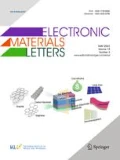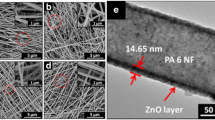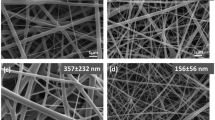Abstract
With the continuous improvement in medical science in modern times, the spread of bacterial infection has become a matter of global concern. Therefore, the search for biological medical materials with antibacterial function has become a focus of intense research. In this work, pure SnO2 and Ag-doped SnO2 hollow nanofibers were fabricated by a combination of an electrospinning method and a calcination procedure, and the effects of the doped Ag on antibacterial activity and catalytic antibacterial activity were subsequently investigated. Through the process of high-temperature calcination, a high heating rate would lead to the formation of a hollow tubular structure in SnO2 fibers, and Ag2O would be reduced to Ag0 by a facile process with appropriate thermal treatment. Additionally, the existence of SnO2 as a tetragonal rutile structure was confirmed. On the basis of pure SnO2, doping with Ag greatly improved the antibacterial activity and catalytic antibacterial activity of hollow nanofibers. The formation mechanism and the antibacterial mechanism of pure SnO2 and Ag-doped hollow nanofibers are also discussed. This study has broad application prospects for biological medicine.
Graphic Abstract










Similar content being viewed by others
References
Zheng, K., et al.: Antimicrobial silver nanomaterials. Coord. Chem. Rev. 357, 1–17 (2018)
Hasan, J., Crawford, R.J., Ivanova, E.P.: Antibacterial surfaces: the quest for a new generation of biomaterials. Trends Biotechnol. 31(5), 295–304 (2013)
Hajipour, M.J., et al.: Antibacterial properties of nanoparticles. Trends Biotechnol. 30(10), 499–511 (2012)
Wang, C., et al.: Large-scale synthesis of SnO2 nanosheets with high lithium storage capacity. J. Am. Chem. Soc. 132(1), 46–47 (2009)
Zhao, L., et al.: Antibacterial nano-structured titania coating incorporated with silver nanoparticles. Biomaterials 32(24), 5706–5716 (2011)
Arciola, C.R., et al.: Biofilm formation in Staphylococcus implant infections. A review of molecular mechanisms and implications for biofilm-resistant materials. Biomaterials 33(26), 5967–5982 (2012)
Magiorakos, A.P., et al.: Multidrug-resistant, extensively drug-resistant and pandrug-resistant bacteria: an international expert proposal for interim standard definitions for acquired resistance. Clin. Microbiol. Infect. 18(3), 268–281 (2012)
Lemire, J.A., Harrison, J.J., Turner, R.J.: Antimicrobial activity of metals: mechanisms, molecular targets and applications. Nat. Rev. Microbiol. 11, 371 (2013)
Sirelkhatim, A., et al.: Review on zinc oxide nanoparticles: antibacterial activity and toxicity mechanism. Nanomicro Lett 7(3), 219–242 (2015)
Besinis, A., De Peralta, T., Handy, R.D.: The antibacterial effects of silver, titanium dioxide and silica dioxide nanoparticles compared to the dental disinfectant chlorhexidine on Streptococcus mutans using a suite of bioassays. Nanotoxicology 8(1), 1–16 (2014)
Zhang, Q., et al.: Low Ag-doped titanium dioxide nanosheet films with outstanding antimicrobial property. Environ. Sci. Technol. 44(21), 8270–8275 (2010)
Ijaz, F., et al.: Green synthesis of copper oxide nanoparticles using Abutilon indicum leaf extract: antimicrobial, antioxidant and photocatalytic dye degradation activitie. Trop. J. Pharm. Res. 16(4), 743–753 (2017)
Tsai, P.C., et al.: Uniform luminous perovskite nanofibers with color-tunability and improved stability prepared by one-step core/shell electrospinning. Small 14(22), e1704379 (2018)
Dias, H.B., et al.: Synthesis, characterization and application of Ag doped ZnO nanoparticles in a composite resin. Mater. Sci. Eng. C Mater. Biol. Appl. 96, 391–401 (2019)
Holtz, R.D., et al.: Nanostructured silver vanadate as a promising antibacterial additive to water-based paints. Nanomedicine 8(6), 935–940 (2012)
Kenry, Lim, C.T.: Nanofiber technology: current status and emerging developments. Prog. Polym. Sci. 70, 1–17 (2017)
Jiang, C., et al.: Facile synthesis of SnO2 nanocrystalline tubes by electrospinning and their fast response and high sensitivity to NOx at room temperature. CrystEngComm 14(8), 2739–2747 (2012)
Huang, H., et al.: Needle-like Zn-doped SnO2 nanorods with enhanced photocatalytic and gas sensing properties. Nanotechnology 23(10), 105502 (2012)
Kumar, S., Hesketh, P.J.: Interpretation of ac dielectrophoretic behavior of tin oxide nanobelts using Maxwell stress tensor approach modeling. Sens. Actuators B Chem. 161(1), 1198–1208 (2012)
Wang, C., et al.: Large-scale synthesis of SnO2 nanosheets with high lithium storage capacity. J. Am. Chem. Soc. 132(1), 46–47 (2010)
Diantoro, M., et al.: Control of dielectric constant and anti-bacterial activity of PVA-PEG/x-SnO2 nanofiber. IOP Conf. Ser. Mater. Sci. Eng. 367, 012012 (2018)
Vasiliev, A.A.E., Varfolomeev, Volkov I.A., Simonenko, N.P., Arsenov, P.V., Vlasov, I.S., Ivanov, V.V., Pislyakov, A.V., Lagutin, A.S., Jahatspanian, I.E., Maeder, T.: Reducing humidity response of gas sensors for medical applications: use of spark discharge synthesis of metal oxide nanoparticles. Sensors 18(8), 2600 (2018)
Jahanshahi, P., et al.: Designing a non-invasive surface acoustic resonator for ultra-high sensitive ethanol detection for an on-the-spot health monitoring system. Biotechnol. Bioprocess Eng. 23(4), 394–404 (2018)
Liu, L., et al.: Improved H2 sensing properties of Co-doped SnO2 nanofibers. Sens. Actuators B Chem. 150(2), 806–810 (2010)
Jiang, M., et al.: Preparation and characterization of hybrid antimicrobial materials based on Zn–Lu composites. J. Mater. Sci. 53(21), 14922–14932 (2018)
Kuru, M., Şaşmaz Kuru, T., Bağcı, S.: The role of the calcium concentration effect on the structural and dielectric properties of mixed Ni–Zn ferrites. J. Mater. Sci. Mater. Electron. 30(6), 5438–5453 (2019)
Mohanapriya, P., et al.: Enhanced ethanol-gas sensing performance of Ce-doped SnO2 hollow nanofibers prepared by electrospinning. Sens. Actuators B Chem. 188, 872–878 (2013)
Chen, Y., et al.: Fabrication of a three-dimensional porous Z-scheme silver/silver bromide/graphitic carbon nitride@nitrogen-doped graphene aerogel with enhanced visible-light photocatalytic and antibacterial activities. J. Colloid Interface Sci. 536, 389–398 (2019)
Gilani, R., et al.: Elucidating the first-principles calculations of SnO2 Within DFT framework and beyond: a library for optimization of various pseudopotentials. Silicon 10(5), 2317–2328 (2018)
Maciela, A.P., et al.: Microstructural and morphological analysis of pure and Ce-doped tin dioxide nanoparticles. J. Eur. Ceram. Soc. 23(5), 707–713 (2003)
Weber, I.T., et al.: Influence of noble metals on the structural and catalytic properties of Ce-doped SnO2 systems. Sens. Actuators B Chem. 97(1), 31–38 (2004)
Gu, C., et al.: Porous flower-like SnO2 nanostructures as sensitive gas sensors for volatile organic compounds detection. Sens. Actuators B Chem. 174, 31–38 (2012)
Choi, Y.-H., Hong, S.-H.: H2 sensing properties in highly oriented SnO2 thin films. Sens. Actuators B Chem. 125(2), 504–509 (2007)
Dong, P., et al.: Plasmon enhanced photocatalytic and antimicrobial activities of Ag–TiO2 nanocomposites under visible light irradiation prepared by DBD cold plasma treatment. Mater. Sci. Eng. C 96, 197–204 (2019)
Cao, P., et al.: Covalent bonding of AgNPs to 304 stainless steel by reduction in situ for antifouling applications. Appl. Surf. Sci. 452, 201–209 (2018)
Basnet, P., et al.: Tea-phytochemicals functionalized Ag modified ZnO nanocomposites for visible light driven photocatalytic removal of organic water pollutants. Mater. Res. Express 6(8), 085095 (2019)
Wei, S., Zhou, M., Du, W.: Improved acetone sensing properties of ZnO hollow nanofibers by single capillary electrospinning. Sens. Actuators B Chem. 160(1), 753–759 (2011)
Dayal, P., Kyu, T.: Porous fiber formation in polymer-solvent system undergoing solvent evaporation. J. Appl. Phys. 100(4), 043512 (2006)
Agnihotri, S., Mukherji, S., Mukherji, S.: Size-controlled silver nanoparticles synthesized over the range 5–100 nm using the same protocol and their antibacterial efficacy. RSC Adv. 4(8), 3974–3983 (2014)
Cai, Q., et al.: Insight into biological effects of zinc oxide nanoflowers on bacteria: why morphology matters. ACS Appl. Mater. Interfaces 8(16), 10109–10120 (2016)
Lok, C., et al.: Silver nanoparticles: partial oxidation and antibacterial activities. J. Biol. Inorg. Chem. 12(4), 527–534 (2007)
Jaiswal, S., et al.: Enhancement of the antibacterial properties of silver nanoparticles using beta-cyclodextrin as a capping agent. Int. J. Antimicrob. Agents 36(3), 280–283 (2010)
Loher, S., et al.: Micro-organism-triggered release of silver nanoparticles from biodegradable oxide carriers allows preparation of self-sterilizing polymer surfaces. Small 4(6), 824–832 (2008)
Li, W.R., et al.: Antibacterial activity and mechanism of silver nanoparticles on Escherichia coli. Appl. Microbiol. Biotechnol. 85(4), 1115–1122 (2010)
Feng, Q., et al.: A mechanistic study of the antibacterial effect of silver ions on Escherichia coli and Staphylococcus aureus. J. Biomed. Mater. Res. 52(4), 662–668 (2000)
Kim, J.S., et al.: Antimicrobial effects of silver nanoparticles. Nanomedicine 3(1), 95–101 (2007)
Acknowledgements
This work was supported by a grant from the National Natural Science Foundation of China, China (21677010). We thank LetPub (www.letpub.com) for its linguistic assistance during the preparation of this manuscript.
Author information
Authors and Affiliations
Corresponding author
Ethics declarations
Conflict of interest
All author declare that they have no conflict of interest.
Additional information
Publisher's Note
Springer Nature remains neutral with regard to jurisdictional claims in published maps and institutional affiliations.
Rights and permissions
About this article
Cite this article
Li, Y., Gao, S., Zhang, B. et al. Electrospun Ag-Doped SnO2 Hollow Nanofibers with High Antibacterial Activity. Electron. Mater. Lett. 16, 195–206 (2020). https://doi.org/10.1007/s13391-020-00203-6
Received:
Accepted:
Published:
Issue Date:
DOI: https://doi.org/10.1007/s13391-020-00203-6




